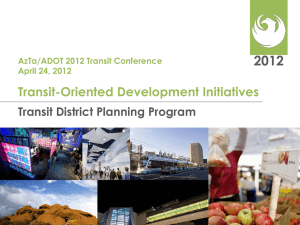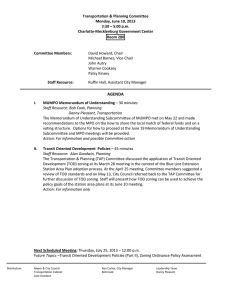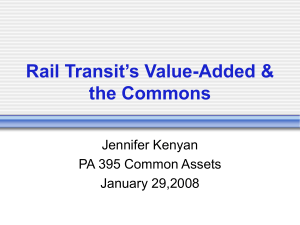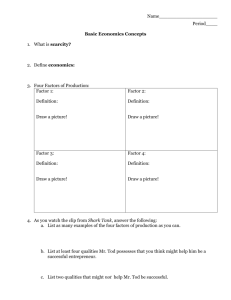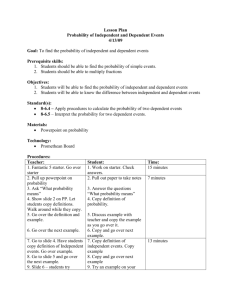IRJET-Transit Oriented Development
advertisement
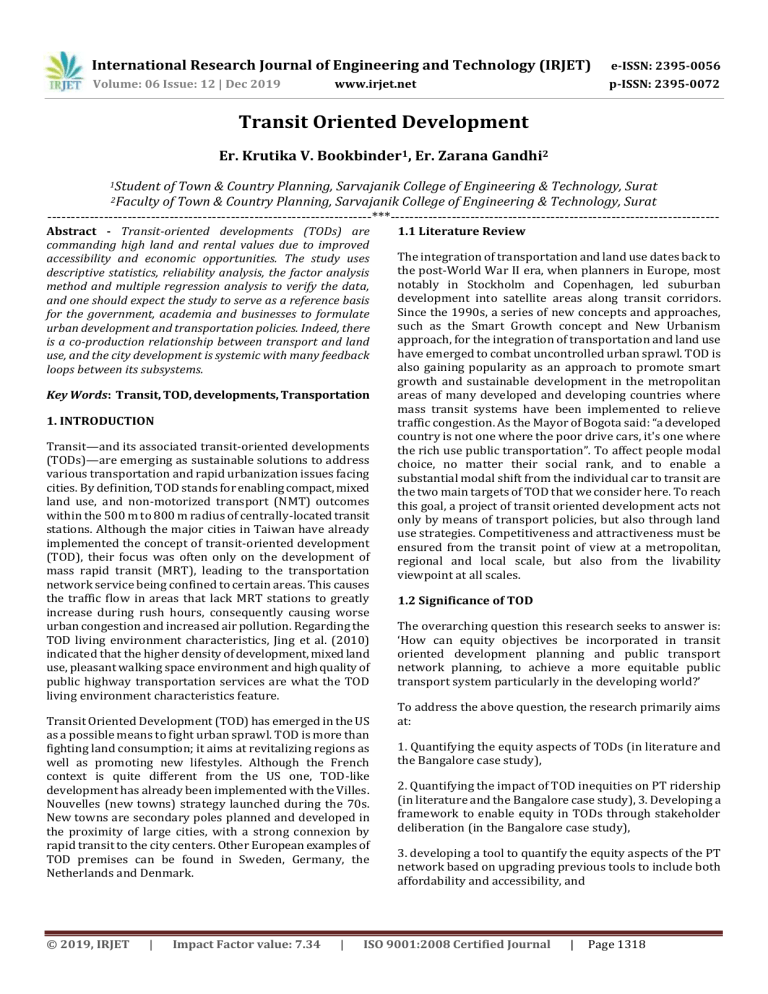
International Research Journal of Engineering and Technology (IRJET) e-ISSN: 2395-0056 Volume: 06 Issue: 12 | Dec 2019 p-ISSN: 2395-0072 www.irjet.net Transit Oriented Development Er. Krutika V. Bookbinder1, Er. Zarana Gandhi2 1Student of Town & Country Planning, Sarvajanik College of Engineering & Technology, Surat of Town & Country Planning, Sarvajanik College of Engineering & Technology, Surat ---------------------------------------------------------------------***---------------------------------------------------------------------2Faculty Abstract - Transit-oriented developments (TODs) are commanding high land and rental values due to improved accessibility and economic opportunities. The study uses descriptive statistics, reliability analysis, the factor analysis method and multiple regression analysis to verify the data, and one should expect the study to serve as a reference basis for the government, academia and businesses to formulate urban development and transportation policies. Indeed, there is a co-production relationship between transport and land use, and the city development is systemic with many feedback loops between its subsystems. Key Words: Transit, TOD, developments, Transportation 1. INTRODUCTION Transit—and its associated transit-oriented developments (TODs)—are emerging as sustainable solutions to address various transportation and rapid urbanization issues facing cities. By definition, TOD stands for enabling compact, mixed land use, and non-motorized transport (NMT) outcomes within the 500 m to 800 m radius of centrally-located transit stations. Although the major cities in Taiwan have already implemented the concept of transit-oriented development (TOD), their focus was often only on the development of mass rapid transit (MRT), leading to the transportation network service being confined to certain areas. This causes the traffic flow in areas that lack MRT stations to greatly increase during rush hours, consequently causing worse urban congestion and increased air pollution. Regarding the TOD living environment characteristics, Jing et al. (2010) indicated that the higher density of development, mixed land use, pleasant walking space environment and high quality of public highway transportation services are what the TOD living environment characteristics feature. Transit Oriented Development (TOD) has emerged in the US as a possible means to fight urban sprawl. TOD is more than fighting land consumption; it aims at revitalizing regions as well as promoting new lifestyles. Although the French context is quite different from the US one, TOD-like development has already been implemented with the Villes. Nouvelles (new towns) strategy launched during the 70s. New towns are secondary poles planned and developed in the proximity of large cities, with a strong connexion by rapid transit to the city centers. Other European examples of TOD premises can be found in Sweden, Germany, the Netherlands and Denmark. © 2019, IRJET | Impact Factor value: 7.34 | 1.1 Literature Review The integration of transportation and land use dates back to the post-World War II era, when planners in Europe, most notably in Stockholm and Copenhagen, led suburban development into satellite areas along transit corridors. Since the 1990s, a series of new concepts and approaches, such as the Smart Growth concept and New Urbanism approach, for the integration of transportation and land use have emerged to combat uncontrolled urban sprawl. TOD is also gaining popularity as an approach to promote smart growth and sustainable development in the metropolitan areas of many developed and developing countries where mass transit systems have been implemented to relieve traffic congestion. As the Mayor of Bogota said: “a developed country is not one where the poor drive cars, it's one where the rich use public transportation”. To affect people modal choice, no matter their social rank, and to enable a substantial modal shift from the individual car to transit are the two main targets of TOD that we consider here. To reach this goal, a project of transit oriented development acts not only by means of transport policies, but also through land use strategies. Competitiveness and attractiveness must be ensured from the transit point of view at a metropolitan, regional and local scale, but also from the livability viewpoint at all scales. 1.2 Significance of TOD The overarching question this research seeks to answer is: ‘How can equity objectives be incorporated in transit oriented development planning and public transport network planning, to achieve a more equitable public transport system particularly in the developing world?’ To address the above question, the research primarily aims at: 1. Quantifying the equity aspects of TODs (in literature and the Bangalore case study), 2. Quantifying the impact of TOD inequities on PT ridership (in literature and the Bangalore case study), 3. Developing a framework to enable equity in TODs through stakeholder deliberation (in the Bangalore case study), 3. developing a tool to quantify the equity aspects of the PT network based on upgrading previous tools to include both affordability and accessibility, and ISO 9001:2008 Certified Journal | Page 1318 International Research Journal of Engineering and Technology (IRJET) e-ISSN: 2395-0056 Volume: 06 Issue: 12 | Dec 2019 p-ISSN: 2395-0072 www.irjet.net 4. Administering the new tool in the Bangalore case study area and providing recommendations for equitable PT at the network level, to demonstrate the value of the tool. 2. Challenges tools to raise funds to invest in transit and other necessary social infrastructure, and these funds are distributed among the government agencies BMRCL, BWSSB, BDA, and BBMP. However, the stakeholders felt that a certain amount of money needs to be allocated to fund affordable housing. Although the community and transportation benefits of TOD can be significant, there are still many major implementation barriers that limit the broader implementation of TOD in California. Based on this study’s review of TOD, Chapter 8 summarizes major barriers to TOD implementation, which include: Additionally, a minority amongst the stakeholders suggested relaxing parking norms as an incentive. However, the others felt that parking norms in Indian cities are already lenient and that further relaxation may amount to illegal street parking. The rest of the tools under inclusionary zoning did not receive significant attention. Transit system location and design. The location and design of transit systems can be a major barrier to successful TOD. Unfortunately, stations often have poor pedestrian access and are not well integrated with the surrounding local community. For example, broad expanses of surface-level parking often separate stations from the surrounding community; and stations and transit corridors are often located in areas with little or no development potential, which significantly reduces transit’s ability to link activity centers. Special-Purpose Vehicle (SPV). The deliberations established that setting up an SPV for station area-level plans can address the lack of collaboration and coordination between and within agencies. SPVs have been set up in other areas of government, but not for TODs. It can bring all of the stakeholders under one umbrella and protect each organization's goals, without compromising the community’s wellbeing. It can facilitate engagement between government entities, developers, and communities with the objective of equitable and sustainable TODs. These engagements can establish development agreements, community benefit agreements, PPP models, and other joint development plans. The SPV can also act as a real estate agency to negotiate with private developers and community coalitions on future developments in exchange for government incentives. Local community concerns. For local neighborhoods, proposals for TOD projects often are associated with concerns about changing the character of a community. Even with quality design and appropriate density, and despite local government support, community concerns about proposed TOD projects often become substantial hurdles to implementation. Local zoning not transit-friendly. In most major transit station sites in the State, local zoning has not been changed to reflect the presence of transit. Local development codes around major stations often tend to favor low density, autooriented uses. Creating and implementing transit friendly zoning becomes an additional hurdle. Higher developer risk and cost. Mixed-use and/or higherdensity projects (such as in TOD) present a higher level of risk for developers and financiers as compared to typical ‘sprawl’. Due to innovative and often high-quality design, TOD can be more costly to build. It is often subjected to more stringent regulations as well as to more complex local approval processes than conventional “auto-oriented” projects, which also contributes to higher development costs. 3. Strategies to Implement Affordable Housing in TODs Inclusionary Zoning. In the case study area, the government owns neither any vacant land for developing affordable housing, nor the funds to acquire highly-priced land. To overcome this hurdle in incorporating affordable housing in new TODs, the stakeholders suggested that inclusionary zoning be mandated through regulations. A majority of them recommended high FAR/density bonuses as incentives to the developers, in exchange for affordable housing. Rather, these are being used as innovative financial © 2019, IRJET | Impact Factor value: 7.34 | 4. CONCLUSIONS Why do we defend TOD as an alternative to the concentration of densities (a dense and compact city)? A multiplicity of questions is at the basis of this research. We try here to give some insights on the issues that we wanted to tackle by conducting this study. Considering our assumption on TOD as an US-made concept, initially implemented in sprawled and big metropolises, we have shown in our research that its implementation in dense and medium French cities is effective in fighting against urban sprawl and increasing transit modal share while keeping or making people satisfied about the living environment. We can somehow say that acceptability of TOD is verified in our scenario (but we would rather not to generalize this kind of result). Lack of Collaboration, Coordination, and Capacity between and within Agencies, and Conflicting Interests. REFERENCES [1] The Journal Of Transport And Land Use https://jtlu.org/index.php/jtlu Vol. 5 No. 3 [2012] pp.83-99 doi: 10.5198/jtlu.v5i3.292 [2] "Transit-Oriented Development: Lessons from Indian Experiences", Rutul Joshi (Centre for Urban Equity, CEPT University) ISO 9001:2008 Certified Journal | Page 1319 International Research Journal of Engineering and Technology (IRJET) e-ISSN: 2395-0056 Volume: 06 Issue: 12 | Dec 2019 p-ISSN: 2395-0072 www.irjet.net [3] "Statewide Transit-Oriented Development Study – Factors for Success in California", Terry Parker, M.A., AICP [4] "Evaluation of a transit-oriented development scenario in a medium-sized French city by simulation models", Olivier Bonin, Lorenza Tomasoni [5] "TOD District Planning Based on Residents’ Perspectives", Chia-Nung Li, Chiang Lin and Tsu-Kuang Hsieh [6] " Incorporating Equity in Public Transport Planning: The case of Bengaluru", Jyothi Chava [7] Hindawi Journal of Advanced Transportation Volume 2018, Article ID 6701484, 10 pages https://doi.org/10.1155/2018/6701484 [8] "HOW PLANNING PROCESS IMPACTS BUS RAPID TRANSIT OUTCOMES: A COMPARISON OF EXPERIENCES IN DELHI AND AHMEDABAD, INDIA", Andrea Rizvi [9] "Stakeholder Deliberation on Developing Affordable Housing Strategies: Towards Inclusive and Sustainable Transit-Oriented Developments", Jyothi Chava and Peter Newman [10] "Ridership and the Built-Form Indicators: A Study from Ahmedabad Janmarg Bus Rapid Transit System (BRTS)", Md Rabiul Islam, Mark Brussel , Anna Grigolon and Talat Munshi © 2019, IRJET | Impact Factor value: 7.34 | ISO 9001:2008 Certified Journal | Page 1320
